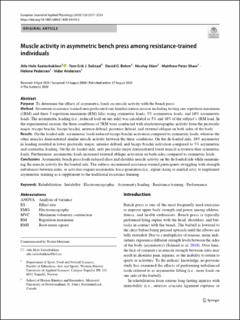| dc.contributor.author | Sæterbakken, Atle Hole | |
| dc.contributor.author | Solstad, Tom Erik Jorung | |
| dc.contributor.author | Behm, David G. | |
| dc.contributor.author | Stien, Nicolay | |
| dc.contributor.author | Shaw, Matthew Peter | |
| dc.contributor.author | Pedersen, Helene | |
| dc.contributor.author | Andersen, Vidar | |
| dc.date.accessioned | 2021-01-06T14:38:52Z | |
| dc.date.available | 2021-01-06T14:38:52Z | |
| dc.date.created | 2020-12-04T11:12:25Z | |
| dc.date.issued | 2020 | |
| dc.identifier.citation | Sæterbakken, A. H., Solstad, T. E. J., Behm, D. G., Stien, N., Shaw, M. P., Pedersen, H., & Andersen, V. (2020). Muscle activity in asymmetric bench press among resistance-trained individuals. European Journal of Applied Physiology, 120(11), 2517–2524. | en_US |
| dc.identifier.issn | 1439-6319 | |
| dc.identifier.uri | https://hdl.handle.net/11250/2721801 | |
| dc.description.abstract | Purpose
To determine the effects of asymmetric loads on muscle activity with the bench press.
Method
Seventeen resistance-trained men performed one familiarization session including testing one repetition maximum (1RM) and three 5 repetition maximum (RM) lifts; using symmetric loads, 5% asymmetric loads, and 10% asymmetric loads. The asymmetric loading (i.e., reduced load on one side) was calculated as 5% and 10% of the subject`s 1RM load. In the experimental session, the three conditions of 5RM were conducted with electromyographic activity from the pectoralis major, triceps brachii, biceps brachii, anterior deltoid, posterior deltoid, and external oblique on both sides of the body.
Results
On the loaded side, asymmetric loads reduced triceps brachii activation compared to symmetric loads, whereas the other muscles demonstrated similar muscle activity between the three conditions. On the de-loaded side, 10% asymmetry in loading resulted in lower pectoralis major, anterior deltoid, and biceps brachii activation compared to 5% asymmetric and symmetric loading. On the de-loaded side, only pectoralis major demonstrated lower muscle activation than symmetric loads. Furthermore, asymmetric loads increased external oblique activation on both sides compared to symmetric loads.
Conclusions
Asymmetric bench press loads reduced chest and shoulder muscle activity on the de-loaded side while maintaining the muscle activity for the loaded side. The authors recommend resistance-trained participants struggling with strength imbalances between sides, or activities require asymmetric force generation (i.e., alpine skiing or martial arts), to implement asymmetric training as a supplement to the traditional resistance training. | en_US |
| dc.language.iso | eng | en_US |
| dc.publisher | Springer | en_US |
| dc.rights | Navngivelse 4.0 Internasjonal | * |
| dc.rights.uri | http://creativecommons.org/licenses/by/4.0/deed.no | * |
| dc.subject | rehabilitation | en_US |
| dc.subject | instability | en_US |
| dc.subject | electromyographic | en_US |
| dc.subject | asymmetry loading | en_US |
| dc.subject | resistance training | en_US |
| dc.subject | performance | en_US |
| dc.title | Muscle activity in asymmetric bench press among resistance-trained individuals | en_US |
| dc.type | Peer reviewed | en_US |
| dc.type | Journal article | en_US |
| dc.description.version | publishedVersion | en_US |
| dc.rights.holder | © The Author(s) 2020 | en_US |
| dc.subject.nsi | VDP::Medisinske Fag: 700::Idrettsmedisinske fag: 850::Treningslære: 851 | en_US |
| dc.source.pagenumber | 2517–2524 | en_US |
| dc.source.volume | 120 | en_US |
| dc.source.journal | European Journal of Applied Physiology | en_US |
| dc.source.issue | 11 | en_US |
| dc.identifier.doi | 10.1007/s00421-020-04476-5 | |
| dc.identifier.cristin | 1856169 | |
| cristin.ispublished | true | |
| cristin.fulltext | original | |
| cristin.qualitycode | 1 | |

